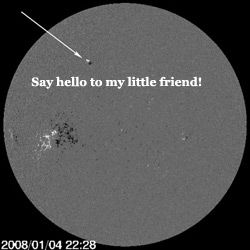The Sun is a variable star. Sunspots – dark regions on the surface of the Sun – increase in number over the years, peak, and then slowly decline once again. The pattern repeats every 11 years. Sunspots are regions of magnetic activity, and that is what fuels the massive eruptions of solar flares and coronal mass ejections (CMEs) off the Sun. These can play havoc with all sorts of human activities: radio communications, GPS satellites, and even lay waste to our power grid (Quebec had a massive blackout in 1989 due to solar activity).
Obviously, astronomers pay close attention to the Sun.
 The last cycle waned a few years back, and our nearest star has been pretty quiet. The predictions were that the new cycle would start up soon… and it looks like it’s poking its head through the door.
The last cycle waned a few years back, and our nearest star has been pretty quiet. The predictions were that the new cycle would start up soon… and it looks like it’s poking its head through the door.
This image (from SOHO) shows the newest spot to blemish the Sun. We can tell it’s part of the new cycle because of the Sun’s magnetic field: sunspots reverse their (magnetic north and south) polarity every cycle, and this spot shows that reversal. So welcome the first spot for Cycle 24!
The spot looks dinky, but don’t be fooled. First of all, it’s several thousand kilometers across – the Sun is big big big. Second, we’ve already seen some activity from it; two blasts of energy have emanated from it since it was spotted a week ago. Magnetic field lines get tangled up, and can suddenly reconnect, making huge explosions on the surface (which can trigger solar flares and CMEs). There is a cool movie of this available, too.
I didn’t know very much about the details of the Sun’s magnetic field and cycles until recently, which is when I started researching them for my chapter on solar flares for my upcoming book Death from the Skies! … and then I learned a lot. This is a fascinating topic, and astronomers discover more about the Sun literally every day. I’ll be very excited to keep track of Cycle 24, at the very least so I can figure out how to milk it for book publicity.